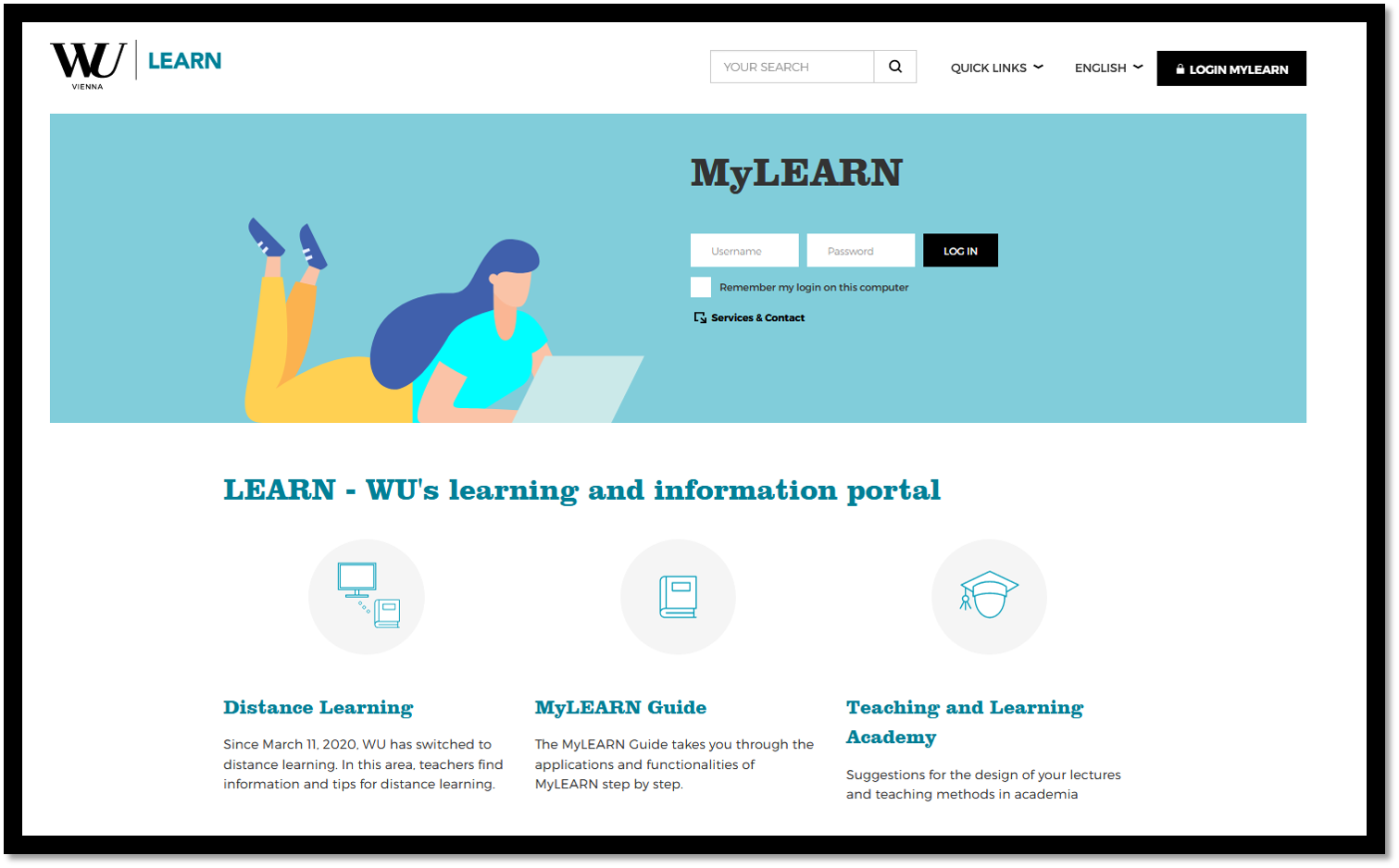We have developed a comprehensive digitalization strategy in recent years. This strategy details how we plan to continue on our way to becoming a modern university. The focus is mainly on digital collaboration, supplementing in-person teaching with digital formats, and digitalizing administrative services. The COVID-19 pandemic and the resulting restrictions on students, faculty, and staff made it necessary to implement key parts of the digitalization strategy at short notice. Thanks to the commitment and dedication of everyone involved, we managed the transition successfully.

The Shift to Teleworking
On March 16, WU’s faculty and staff started a new work week unlike any they had experienced before. Due to the pandemic, they were working from home. In the days leading up to the lockdown, the IT-Services team worked tirelessly to facilitate the transition. A comprehensive range of support offers helped the WU community rapidly become familiar with new tools for online communication and cooperation and use them to access documents and programs on the WU network.
Faculty and staff began using the new functions right away, connecting with each other from their workplaces at home. Within just a few days, video conferences and chats became an integral part of our everyday work.
The “Digitally Connected” initiative was launched during the year. With this program, we provided our employees with information and workshops to help them make a successful transition to digital and hybrid work and meeting formats. Teleworking is associated with increased information security risks. We took a number of technical precautions to ensure security and created a new training program for WU employees.
Changes in the use of WU’s IT infrastructure resulting from the switch to teleworking and distance learning in March/April
- 40% increase in email activity
- Four-fold increase in simultaneous active VPN connections to the WU network
- 60% increase in SharePoint activity
- up to 12,000 messages, 700 calls, and 1,000 online meetings daily
The Shift to Distance Learning
While WU’s employees made the transition to telework in mid-March, our students had to switch to studying from home as well. All courses were converted to distance learning formats within 24 hours thanks to the excellent support provided by the distance learning team, which included contributions from IT-Services, Digital Teaching Services, and many others. In this context, of course, the commitment of the entire WU community – faculty, staff, and students – was key.
WU’s eLearning platform LEARN played a central role. This platform has been an integral part of WU’s teaching for many years. Students use the platform to access learning materials, strengthen the skills they learn in class with interactive exercises, and stay in touch with teachers and fellow students. Teachers can stream lectures or make them available as videos. Even exams can be held on LEARN. With the shift to distance learning, activity levels on the platform have increased many times over. In March 2019, the download volume was around 136 GB/day; in March 2020, the daily download volume reached up to 1,300 GB on individual days.
Communication platforms are used for video conferencing, livestreams of courses, and online exams. Many of the WU Library’s resources, including databases, eBooks, and eJournals were freely accessible online even before the coronavirus crisis. To aid distance learning, digitalization services were expanded and additional emphasis was placed on personal support.

WU’s eLearning platform
- Users: 23,000 students and 1,200 teachers
- Use: Up to 12,000 logins/day and up to 2,000 students active on the platform simultaneously
- Learning and practicing: Over 30 eLearning tools and more than 200,000 learning materials in a variety of multimedia formats
- Self-organization for students: a personal calendar, individual to-do lists with deadlines and assignments, online homework submission, and access to grades
- Communication: Discussion forums and chat platforms, notifications for course-related news
The human factor
In addition to the technical infrastructure, the members of the WU community played a key role in making the transition from in-person teaching to distance learning a smooth one. Switching to distance learning meant a considerable additional effort for all involved – thanks to the commitment of the entire community, we were able to maintain the high quality of all our programs without any interruptions.
Students were largely satisfied with online teaching. For almost all instructors, creating learning materials for distance learning formats was more time-intensive than in-person teaching. Students were very appreciative of the extra effort, especially of the newly developed elements that helped keep courses interesting and students motivated in this particularly challenging situation.
Students’ workload increased mainly due to the amount of independent study required and the additional efforts needed to coordinate virtual cooperation. The extra work paid off: Around three out of four of all teachers were very satisfied with their students’ performance.
Both groups found it particularly important to find a common basis for cooperation in this unusual situation and to keep the lines of communication and interaction open in the teaching-learning setting. For teachers, it was immensely important to be present right from the start and to let students know that they had the situation under control. Motivation and active participation were the most important factors for success in distance learning formats. The biggest challenges for both groups were (and remain) the lack of personal contact and maintaining the lines of communication.

Successful Online Exams
WU holds large-scale exam weeks three times per semester. Some of these exams are taken by over 1,000 students at the same time. As early as April 2020, we were faced with the decision of either canceling exams or moving them online. It was important to us to make sure students could take the exams they need to make good progress in their studies. So we started thinking about how to make this happen.
Even in normal times, large-scale exam weeks are an enormous (logistical) challenge due to the sheer numbers of participating students. During a pandemic, the organization and implementation suddenly became a great deal more complex and difficult. Within a period of just four weeks, over 100 people, including teachers, programmers, academic counselors, and legal specialists created the infrastructure and conditions necessary for successfully holding online exams.
The first large-scale exam week was held online in late April. Over 12,300 exam attempts were counted in a total of 38 exams, and up to 900 students took part in the largest exams at the same time.

